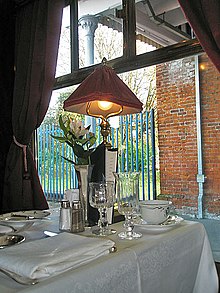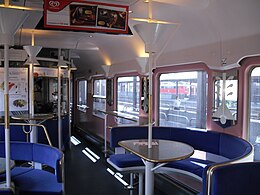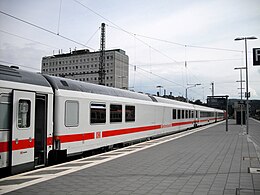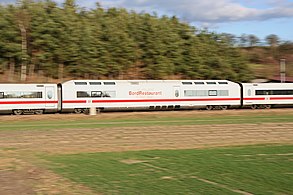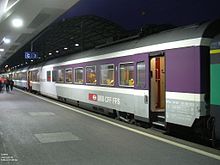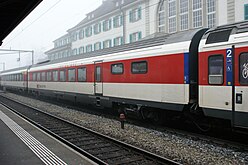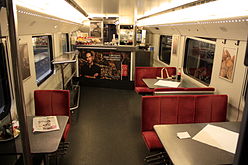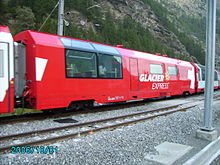Dining car

A dining car is a railway car specially set up for the purchase and consumption of food and drinks by travelers during the journey . As a rule, dining cars therefore have a dining room with a restaurant-like interior and a kitchen ( galley ).
In full dining cars , all seats are in the dining room. In the half dining car there are also normal seats not intended for the consumption of food and drinks, which can be used as an extension of the dining area with some types if necessary.
history
Before the introduction of dining cars, travelers had to fall back on offers of food and beverages at the subway stations. In spite of the planned particularly long stay times - for example, at lunchtime or the option to purchase hot take-away meals - this supply system proved to be inadequate, especially since the journey times were sometimes more than twice as long as today.
The use of dining cars initially met with fierce resistance from the train station hosts, who saw financial disadvantages due to the competition with their offer. Ultimately, however, it turned out that these concerns were unfounded, parallel to the triumphant advance of the dining car, the business of the train station innkeeper with the supply of travelers before or after a journey or at transfer stations flourished. In addition, there were also reservations on the technical as well as the hygienic side, as the dining cars increased the train weights without creating additional passenger capacity, and any kitchen or food smells carried by the train were considered harmful.
The first attempts to entertain travelers during the journey took place in the USA. The Baltimore and Ohio Railroad installed a small restaurant with bar and kitchen in a passenger car as early as 1863, and the Chicago & Dalton Railroad started using a dining car built by the Pullman company in 1868 . A dining car is said to have been in service in Russia between Moscow and Odessa as early as 1870. A Pullman car that was in operation in Great Britain from 1874, the parlor car called "Victoria", however, did not have its own kitchen, the food had to be prepared in a stationary manner and then carried into the car. From November 1, 1879, passengers on the Great Northern Railway between London and Leeds could be catered for in a dining car.
Germany
Regional railways

The first German dining cars were improvised by the International Sleeping Car Company ( Compagnie Internationale des Wagons-Lits , CIWL for short) by converting some third-class cars on the Berlin-Anhalter-Eisenbahn and from July 1, 1880, first between Weimar and Bebra, then between Berlin and Bebra used. The kitchen for food preparation was not in the actual dining car, but in a subsequent baggage car.
The background to the newly created dining car range was that the Prussian State Railroad had been using an express train between Berlin and Bebra since May 15, 1879, which reached Bebra 15 minutes faster than the express train of the Thuringian Railway Company via Halle on the newly built route via Güsten and Sangerhausen and Erfurt. To compensate for this competitive disadvantage, the Thuringian Railway Company wanted to offer its passengers a special service with the first German dining car.
This dining car service was operated by the CIWL until 1884. After the nationalization of the Thuringian Railway Company, the contract was terminated and the management of the dining car was transferred to Halle station manager Gustav Riffelmann on October 15, 1885.
The first completely new dining car - also the first German car with a kitchen - was manufactured in Germany in 1880 by the Rathgeber company in Munich.
The decisive impetus for the widespread use of dining cars came with the introduction of through trains , D-Zug for short, where passengers could change cars and thus also to the dining car during the journey. When the first express train ran from Berlin to Cologne on May 1, 1892, Gustav Riffelmann was also allowed to operate the dining car of this train. As a result, other private operators took over the management of dining cars for the Prussian State Railways. In some connections, the dining car was only accessible to "upholstered class" passengers. If a 3rd class traveler wanted to use the dining car, he had to pay the price difference to 2nd class for the distance he was sitting there.
The dining cars in Mecklenburg, in southern Germany (Grand Duchy of Baden, Kingdom of Bavaria and Kingdom of Württemberg) and in Austria-Hungary were operated by the CIWL until 1917.
Before the First World War, the food on offer in the dining car ranged from a simple continental breakfast to a varied dinner menu. In August 1913, for example, the Deutsche Eisenbahn-Speisewagen-Gesellschaft offered a five-course lunch - including beef broth, turbot with butter, roast beef with cauliflower, leg of venison with lettuce and compote, as well as desserts, cheese, butter and bread - for three marks at the Deutsche Eisenbahn-Speisewagen-Gesellschaft . When using the dining car, there were times when meals were offered together. Seat tickets were issued beforehand and the places were reserved for the participants. A uniform menu was served, eating à la carte was not possible. It was then not allowed to smoke in the whole car. In the remaining times, part of the car was smoking section. Only those who consumed drinks or food were allowed to stay in the dining car.
Mitropa
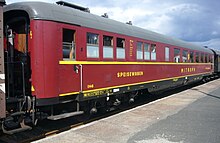
In 1917, the newly founded Mitropa took over the dining cars of the previous private companies Riffelmann, Kromrey , DESG, NSG and Scheidling as well as the ISG cars that were expropriated because of the First World War .
As a result of the Versailles Treaty , the ISG had to be reinstated in its old rights. During the Weimar Republic, Mitropa therefore only operated dining cars in domestic traffic on the Deutsche Reichsbahn as well as in traffic with Scandinavia and the Netherlands.
Mitropa acquired its first own new car - painted burgundy red - from 1924.
On June 1, 1942, the dining car traffic in the German Reich was stopped, but dining cars continued to run in the occupied states.
After the Second World War , Mitropa was split up, the East German part retained the name due to the company's headquarters in Berlin and operated the dining cars in the German Democratic Republic and in transit traffic - as well as the motorway service stations .
After reunification , the joint management company was again called Mitropa from 1994 to 2002.
German Reichsbahn
As the first new dining car for the DR, nine 22.9 meter long Reko dining cars were built in 1960/1961 on the basis of old, usable underframes at the Gotha plant. They shared the large sliding door at the end of the car with the two- and three-axle Reko cars. Five cars from 1960 were converted from seating cars and kept the gooseneck bogies of the donor cars, the four remaining cars from 1961 were converted from dining cars and received new type Görlitz V bogies.
In 1962, twenty WRg (later WRme) dining cars were purchased from Waggonbau Bautzen for international traffic and interzonal trains, which, despite their greater length of 24.9 meters and one-piece revolving doors , are classified as UIC-Y . The interior was divided into two dining rooms with 24 and 18 seats, the partition between them with an oval opening gave this car its own character. The kitchen was equipped with an oil-heated stove. One car was experimentally equipped with a generator and microwave ovens. Two cars were painted light blue for the Tourex , the rest in red with yellow decorative lines, which were later omitted, but were reattached to at least one car at the end of the service life. At the beginning of the 1990s, most of the cars were scrapped and sold to interested parties such as museum railways.
From 1967 to 1969 17 modernization type Bgr buffet cars were built at the Delitzsch plant.
50 WRge type dining cars were built between 1973 and 1975 at the Halberstadt plant. With a length of only 18.7 meters, these corresponded to the remaining four-axle Reko wagons. Görlitz V bogies allowed 140 km / h (from 1986 120 km / h), the multi-voltage heating allowed use in international traffic, which only happened in exceptional cases. The dining room offered space for 24 guests on red seats covered with artificial leather in a 2 + 2 arrangement. Next to the dining room was the 5.30 meter long buffet wing with counter and the 3.90 meter long kitchen including the pantry. On the side facing away from the side aisle, the first cars had only four windows, and later six windows. All cars were painted in Mitropa red with two Mitropa logos on each side, and the designation "dining car" was initially in four languages under the roof edge. Twenty cars were repainted orange-beige from 1976 to 1987 for city express traffic. Most of the other Reko dining cars were converted into Wgr buffet cars between 1985 and 1987 and painted fawn-beige. Today, 21 dining cars and 22 buffet cars of the Reko design have been preserved, some of which have been refurbished for use in museums.
In 1984, 26 WRme dining cars (later WRm 130 ) were finally built in Bautzen. With a length of 26.4 meters, they corresponded to the UIC-Z type . In addition to a dining room with 42 seats, they offered a modern kitchen and, as a special feature, a shower cubicle for the staff. The wagons were initially used in transit trains and international trains, and from 1992 they were also used in intercity traffic, for which some of the originally painted red wagons were modernized and, in accordance with the then current product colors of the German Federal Railroad , were painted in an oriental red-light gray with pastel violet accompanying stripes. A car was temporarily running in blue for the CityNightLine . After 2000, the wagons were taken out of service and some were sold to museum railways.
From 1988 to 1991 eleven Bomk buffet cars were built from the Bom 281 compartment car . In addition to compartments in the second class, there was a counter and a dining area. These cars were withdrawn from regular operation just a few years later.
Deutsche Bundesbahn and Deutsche Bahn
At the Deutsche Bundesbahn , the DSG ( German sleeping and dining car company , later operating as the Deutsche Bahn service company ) was responsible for the management of the dining car .
Until 1962 there were new dining cars only for Allied purposes or buffet and half-dining cars of the types ARbum 216 , BRyl 446 and BRbumh 282 . Otherwise, only about 86 dining cars taken over from Mitropa were used by DSG.
However, for the F-train use the DB procured in 1954 eight half dining car (AR4ümh-54, later ARbum 216 ) with dining room with 30 seats and three first class - compartments . Furthermore, in the 1950s, half-dining cars without the usual center entry were procured to match the type “yl” express train cars (BR4ymg-54, later BRyl 446 ). One car now belongs to the Passau Railway Friends
The Deutsche Bundesbahn first introduced new dining cars in the TEE Rheingold in 1962 . Because with partly double-level supply tract of Rheingold design not proven, were 1,964 new dining car types type WRmh 132 and from 1969 WRmz 135 (with pantograph ) on the market. Part of the WRmh 132 was painted red, the rest in red-beige TEE colors. 1966 followed semi- dining car ARmz 211 (with pantograph), ARmh 217 and ARmz 218 , first in the characteristic blue-red two-tone paint (the cars were nicknamed " Kakadu " because of this color combination ), which gave way to the TEE paintwork from 1971. The half dining car had an open plan, first class, with tables that could be used as a dining room if required. The pantograph was used for power supply during a train stop in the network of the German Federal Railways, the Austrian Federal Railways and the Swiss Federal Railways . A single car - a WRmz 135.1 - was suitable for use in France .
All of these cars (except the WRmh 131 ) were 27.5 meters long, as were the Quick Pick cars that followed. In the 1970s and 1980s, the dining cars were mainly used in TEE and IC traffic and carried the TEE paint, with the apron being painted red instead of black-gray from around 1980 and large restaurant logos. With WRmz twice, with ARmz once per car side. From the end of the 1980s, the dining cars were given the new colors of orient red / light gray with a pastel purple stripe. Today some former ARmz are used as second class buffet cars in the alex .
In the TEE Rheingold, so-called “club cars” were also used, converted open-plan cars in which, in addition to a selection of dishes, music and other entertainment were offered. From a culinary point of view, the meals in the club car were only very modest compared to the pre-war Rheingold. In addition to snacks such as hot dogs or a pair of white sausages with mustard and pretzels, the passenger could only choose, for example, between a cold platter, a goulash soup, a chicken stew and a single alternating main course - called “club car delicacies”, such as meat loaf with mustard and pretzels . A double-deck dining car (humpback dining car) in traditional Rheingold paintwork (blue beige) is part of the car park of the Cologne Railway Association
Tourist dining car
From 1965 on, eighteen WRtmh 134 dining cars were procured especially for trains in regular tourist traffic (special travel agency trains) , which were also known as rolling refrigerators due to their large storage space . They made it possible to meet a large number of travelers on long journeys e.g. B. to Port Bou on the Spanish border without reloading. These cars were initially painted purple, later ivory / ocean blue. Like the WRmh 132 procured at the same time, they are 27.5 m long and approved for a top speed of 160 km / h, but not air-conditioned. Due to the large cargo space, there are only 30 seats in the dining room. Propane gas is used for cooking . The car has a large battery capacity for long journeys. The car can be heated with electricity and steam.
In 1983 three of these wagons were converted for the FernExpress Königssee in WRtmh 136 , the dining room was now managed as a cafeteria and a supervised play area called a children 's area was set up in the former storage room . Other cars were adapted as club cars for the Alpen-See-Express tourist train .
A WRtmh 134 belongs to the wagon fleet of the historic steam express train . Because of its steam heating, it is also used in special steam trains. A bar was built into the children's area
Two other former WRtmh 136 pushchairs are part of the Euro-Express fleet . The carriage was converted into a dance carriage with a bar; the interior was completely redesigned.
Quick pick
After three prototypes built in 1973, the German Federal Railroad procured a series of so-called quick-pick wagons of the type WRbumz 139 between 1975 and 1977 . They each carried a pantograph. One part was painted in the TEE colors red-beige, another in the then current corporate design ocean blue-beige. In the Quick Pick trolley, the customer had to serve himself at a buffet in the canteen and then pay at a cash register. With the introduction of the hourly intercity trains in 1979, all cars were used in intercity traffic. After complaints from passengers and tourism associations regarding the service quality, at least one other operator was deployed in the car. Since the self-service concept was nonetheless unsuccessful in the long run, the quick-pick wagons were converted into WRmz 137 on-board restaurants from 1987 onwards .
Bistro cafe
A new catering concept was developed for the Interregio trains introduced in 1988 . From express train wagons 1./2. Class of the genus ABm 225 were the first as a Bistro Café ARkimbz designated 262 (originally called ARbuimz 262 refers) rebuilt.
The hinged folding door at the end of the 1st class was widened with an additional manually operated door leaf and a wheelchair-accessible toilet, a driver's compartment, two four-seater first-class compartments and an open-plan room with ten places and wheelchair space were set up, while the side aisle was widened so that it can accommodate wheelchairs can be happened. In the former 2nd class half there are five tables with semicircular benches at different heights, a high table and a small kitchen with a service counter, where simple meals can be warmed up and tapped drinks can be served. There were originally various art objects in the dining room. The cars were equipped with air conditioning. Originally the dining room was a smoking area, since 2006 smoking has been banned in the entire car.
After the end of the interregional system, the ARkimbz were used in intercity trains. After the installation of electronic train destination and reservation displays, they are referred to as ARkimbz 266 , the label changed to on- board bistro . Since Deutsche Bahn cannot yet do without the locomotive-hauled Intercity fleet, ARkimbz have been modernized since 2012 and have raised tables with a different seating arrangement, the seats in the 1st class area have been renewed in accordance with the ICmod program. After completion of the technical modernization, the new name is ARkimmbz 288 .
McTrain
In 1993, McDonald’s tried to sell its products in bistro-like dining cars under the McTrain name on some German routes . The experiment failed after a few months because the company did not achieve the profits it had hoped for.
Buffet trolley
Starting in 2000, ten cars were converted into dining cars with buffet WRmbz 138 for car and night trains . Some of the cars for the Berlin-Warszawa-Express have also been redesigned with individual chairs and tables.
On-board bistro
The five-part electric ICE-T trains of the 415 series, some of the seven-part trains of the 411 series and the four-part diesel-powered ICE TD ( 605 series ) were only delivered from the factory with an on-board bistro. The on-board restaurants of the ICE 3 , which will run from 2000, were converted into on-board bistros as early as 2002 in order to increase seating capacity. Since this concept did not work, there is now a dining room with second class seats.
On-board bistro of the ICE-T
On-board restaurant
From 1988 onwards, a new concept was introduced with the on-board restaurants converted from former Quick-Pick cars (the company's own spelling also called BordRestaurant): Meals were no longer prepared in the dining car, but mainly externally as a ready-made meal , which was only prepared in the dining car using a microwave or steamer is warmed up. The reason for this is the faster service and the lower personnel costs on the train. Due to the labor-intensive concept with a two-part kitchen, the WRmz 137 are no longer part of Deutsche Bahn's operating portfolio , they have been partially rebuilt or sold to Austria and Romania.
A part of the WRmz 135 was converted into on-board restaurants WRmz 133 with completely renewed interior and kitchen from 1999 , the pantograph was omitted during this conversion. From 2002 they were equipped with passenger information systems and designated as WRmz 134 . Until they were retired in 2014, these wagons were the only full dining wagons in locomotive-hauled EC / IC trains operated by Deutsche Bahn; other types were available on the City Night Line . In push-pull train operation , the 27.5 m long wagons were overbuffered , which is why their use in pushed trains was banned from 2012. As a result, some wagons were equipped with new buffers on a trial basis , which led to further problems. No further modifications were made, as the most important lines have been converted to ICE and locomotive-hauled trains only run on subordinate lines on which an on- board bistro car is considered sufficient. Two cars were sold to Bahnouristikexpress in 2016 .
The ICE 1 was delivered with an on-board restaurant car in which a dining room and a bistro area can be served from a central kitchen. This can be recognized by the raised roof with additional skylight windows. As an experiment, the dining rooms in some trains were converted into lounges with leather armchairs for first-class passengers and instead an on-seat service was offered, but the attempt was canceled due to lack of probation. During the modernization of the ICE 1, the red leather-covered benches that were originally installed in the ICE 3 were reused in the dining car instead of the original loose chairs.
Since the other ICE generations are designed as half-trains, i.e. one full train leads to two train restaurants, the concept had to be simplified. The ICE 2 , ICE 3 and ICE T have half-dining cars without a raised roof (ICE T sometimes only has an on-board bistro).
DB Fernverkehr has been managing its own trains since 2002. In 2009, the company generated 84.3 million euros in on-board catering, with a double-digit million loss. The highest turnover to date (as of June 2010) was achieved in 2008 with 88 million euros.
In mid-2010, 1,900 people worked in 390 dining cars and 250 on-board bistros. In mid-2012, DB AG owned a total of 157 dining cars for locomotive-hauled trains and a further 259 on-board bistros and on-board restaurants on Intercity Express trains.
On-board restaurant of the ICE 1 with a raised roof
On-board restaurant of the ICE 2
On-board restaurant of the ICE T.
Regional traffic
In 1984 a sales kiosk and vending machines for snacks and drinks were tested in the city railway . This led to the conversion of further local transport vehicles under the name Kaffeeküch . These cars are no longer in operation today.
In some cases, DB Regio supplements highly frequented train runs with special wagons that have a SnackPoint (a vending machine for goods and drinks). The metronome also uses such cars.
A kind of bistro called the ZugCafé has been introduced on some Regional Express lines in North Rhine-Westphalia . These double-decker bistro cars have now been converted back to normal double-decker cars, most recently (until December 2014) they were used on the RE 2 " Rhein-Haard-Express " line, where the bistro area was only open during rush hour from Monday to Friday . In the past, the RE 7 “ Rhein-Münsterland-Express ” line was also operated by the “ZUGIT” catering service. There were china dishes and freshly tapped beer.
Smoke-free dining cars and bistros
Since October 1, 2006, the ban on smoking has been in effect in the dining cars of Deutsche Bahn . At the same time, the ÖBB dining cars were completely converted to non-smokers. In the Swiss dining car there has been a smoking ban for some time, as in all rail vehicles in Switzerland.
Debate about the range of dining cars
The operation of dining cars is a losing business for the railway. Therefore, there have been several debates, mostly initiated by Deutsche Bahn, about abolishing dining cars or on-board restaurants or at least restricting the range. The corresponding statements z. B. von Hartmut Mehdorn met with fierce criticism, the Deutsche Bahn then withdrew from these plans. The current on-board service offer will therefore be continued at today's level in the future, despite losses. The ICE 4 has an on-board restaurant with 22 seats.
Closure of the IC on-board restaurants WRmz
In the first half of 2014, the DB put down all wagon type WRmz after it pushed in sets in Stuttgart main station to the overriding of buffers was due to an appropriate buffer design. The original plan was to retrofit the wagons and then put them back into operation immediately. This means that in future, locomotive-hauled DB trains will only use bistro cars of the ARkimbz type.
List of dining and buffet cars (DB and DR)
| Type | Construction year | Number | length | Pantograph | Art | Remarks |
|---|---|---|---|---|---|---|
| ADmh 101 | 1962 | 5 | 26.4 m | No | Observation car | for Rheingold and Rheinpfeil |
| ARDmh 105 | 1964 | 12 | 27.5 m | No | Bar cart | for TEE traffic |
| ARDmz 106 | 1964 | 5 | 27.5 m | No | Bar cart | for TEE traffic |
| WRm 130 | 1984 | 26th | 26.4 m | No | ex DR (Bautzen), modernized from 1992 | |
| WRmh 131 | 1962 | 5 | 26.4 m | No | partly two-story supply wing | |
| WRmz 131 | 1995 | 7th | 26.4 m | No | for CityNightLine , conversion from DR-Apmz / Bpmz | |
| WRmh 132 | 1964-68 | 27 | 27.5 m | No | later WRmz 132 | |
| WRtmh 133 | 1964 | 3 | 26.4 m | No | Tourist car | |
| WRmz 133 | 1999-2001 | 24 | 27.5 m | No | Conversion from WRmz 135 | |
| WRtmh 134 | 1965 | 18th | 27.5 m | No | Tourist car | three cars converted into the Alpen-See-Express club car in the 1980s (without changing numbers) |
| WRmz 134 | 2003-04 | 24 | 27.5 m | No | Conversion from WRmz 133 ( FIS ) | |
| WRmz 135 | 1969-73 | 36 | 27.5 m | Yes | one car with multiple voltages (France) | |
| WRtmh 136 | 1983 | 3 | 27.5 m | No | Cafeteria / children's area | Conversion from WRtmh 134 |
| WRkmz 136 | 1993 | 2 | 27.5 m | Yes | MC Donalds | Conversion from ARmz 211 |
| WRmz 137.0 | 1987-89 | 40 | 27.5 m | Yes | Conversion from WRbumz 139 | |
| WRmz 137.1 | 1993 | 3 | 27.5 m | No | Conversion from WRbumz 139 , multi-voltage capability | |
| Wwc 138 | 1973 | 3 | 26.4 m | No | Quick-Pick (prototype) | Conversion from BRbum 282 |
| WRmbz 138.1 | 2000-02 | 10 | 26.4 m | No | Conversion from ARkimbz 262 for DBAutozug | |
| Wrbumz 139 | 1975-79 | 43 | 27.5 m | Yes | Quick pick | |
| ARmz 211.0 | 1971 | 56 | 27.5 m | Yes | Half dining car | originally red / blue ("cockatoo") |
| ARmz 211.1 | 1971 | 6th | 27.5 m | Yes | Half dining car | originally red / blue ("Kakadu"), capable of multiple voltages, modernized for ECs from 1991 , later three cars in the BWE |
| ARm 216 | 1954 | 8th | 26.4 m | No | Half dining car | originally red / blue ("Kakadu"), for F trains |
| ARmh 217 | 1966 | 25th | 27.5 m | No | Half dining car | originally red / blue ("cockatoo") |
| ARmz 218 | 19 ?? | 15th | 27.5 m | No | Half dining car | Conversion from ARmh 217 |
| ARkimbz 262 | 1988-92 | 155 | 26.4 m | No | IR bistro | Conversion from ABm 225 |
| ARkimz 262.6 | 2012 | 26.4 m | No | IR bistro | without handicapped accessible toilet, only redrawing | |
| ARkimbz 266 | 2003 | 26.4 m | No | IR bistro | Conversion from ARkimbz 262 ( FIS ) | |
| BRbumh 281 | 1960 | 2 | 26.4 m | No | Buffet car | |
| BRbumh 282 | 1962 | 50 | 26.4 m | No | Buffet car | Conversion into a company car and Quick-Pick (prototype) |
| BRbum 282.1 | 1968 | 2 | 26.4 m | No | Food truck | Conversion from BRbum 282 |
| BRbumh 283 | 1962 | 3 | 26.4 m | No | Buffet car | different seating arrangement than BRbumh 282 |
| BRbumz 285 | 1971 | 5 | 26.4 m | No | Snack bar | |
| ARkimmbz 288 | 2015 | 26.4 m | No | IR bistro | Conversion from ARkimbz 266 (technology package "IC mod") | |
| BRyl 446 | 1954 | 3 | 26.4 m | No | Half dining car | Express train design |
| Bomk 539 | 1988-91 | 11 | 26.4 m | No | Buffet car | ex DR (Halberstadt), UIC-Z car , conversion from DR-Bm |
| WRge 542 | 1973-75 | 50 | 18.7 m | No | ex DR (Halberstadt), new buildings in the style of the four-axle reko cars , from 1977 z. Partly repainted in ivory-orange for the city express , rest of 1985-87 conversion to Wgre buffet car. | |
| WGmh 854 | 1983 | 3 | 26.4 m | No | Rheingold Club | Conversion from Apmz 121 |
| WGtmh 855 | 1978 | 3 | 26.4 m | No | TUI meeting | one car for 200 km / h, two for 160 km / h, 1993–1998 for Deutsche Bahn |
| WRkmz 858 | 1995 | 2 | 26.4 m | No | Tourist train | Conversion from Bpmz 293.2 |
| WRkmz 858.1 | 1995 | 2 | 27.5 m | Yes | Tourist train | Conversion from WRmz 137 |
| WRg | 1960-61 | 9 | 22.9 m | No | ex DR (Gotha), outwardly adapted to the two- and three-axle Reko cars with sliding doors on one side | |
| WRme | 1962 | 20th | 24.9 m | No | ex DR (Bautzen), UIC-Y forerunner , RIC-capable | |
| Bgr ??? | 1967-69 | 17th | 21.25 m | No | Buffet car | ex DR (Delitzsch), modernization car |
Remarks:
- The last UIC type number and original number are given.
- The generic names are explained under UIC type designation system for passenger coaches .
- Modification years are in italics .
- Types of wagons in bold are currently in regular use by Deutsche Bahn (others are sometimes used by private and museum railways).
Dining cars in trams
A special feature was that in the past, a dining car was added to the trains of the regional tram between Düsseldorf and Duisburg as well as Düsseldorf and Krefeld for decades at certain times of the day. Later, a dining compartment was set up in the longer articulated tram cars that were then used . Until December 2014, passengers on the Rheinbahn U 76 line between Düsseldorf and Krefeld (the former “ K-Bahn ”) were able to purchase small meals and drinks during the journey. The service on the U 79 line between Düsseldorf and Duisburg (the former “ D-Bahn ”), which is operated jointly by the Rheinbahn and the Duisburger Verkehrsgesellschaft (DVG), was also previously discontinued at the instigation of DVG.
Individual other tram operators also experimented with dining compartments, such as in Bonn and Hanover , but they could not establish themselves in continuous operation. Today there is a bistro compartment in some trains of the Stadtbahn in Karlsruhe .
Austria
From the end of August 1885, the k. k. privileged Austro-Hungarian state railway company on the routes Vienna – Bodenbach and Vienna – Budapest a restoration car of the International Sleeping Car Company . The first test drive on the Vienna – Budapest route took place on August 30, 1885.
From 1927 to 1939, on the route of the Wiener Lokalbahn to Baden, every express train featured a railcar with a buffet car. In this, coffee, pastries and snacks were served by a waiter on white-covered tables. The seating was 2 + 1. This dining car service, which by the way resembled a coffee house on wheels, was operated by the Viennese coffee house Pöchhacker.
In Austria , after the Second World War, the CIWL again operated its own dining car, including a new type built by SGP in 1950 . From 1965 onward dining cars were also built for the ÖBB 4010 multiple units , and in 1966 ten semi-dining cars with 2nd class compartments were purchased for domestic traffic and trains to Switzerland and Germany. In 1977 and 1981, ten air-conditioned full dining cars for international traffic were added, and in 1982 ten half-dining cars with open plan 2nd class for domestic traffic (so-called " long Schlieren cars ") were added. In addition, there were buffet cars in domestic transport. For this purpose, old wagons from the 1930s were modified, and later appropriately equipped “ Schlierenwagen ” and “Lange Schlierenwagen” were procured. Some of the intermediate cars of the ÖBB 4010 multiple units were also set up as buffet cars.
All of these wagon types are now out of regular service or have been converted into other wagon types. Today, 3 dining cars from 1988 (13 more were sold) and 18 pressure-proof dining cars from 1991 operate in Germany and across borders. From 2004 to 2010, 10 on-board restaurant cars were also operated by Deutsche Bahn AG (formerly WRmz 137 ).
The dining car was operated by the CIWL until 1996 . After an interlude with the Trainristo company , the dining cars were operated from 2001–2012 by the è-express company owned by restaurateur Josef Donhauser. In 2011 the catering was put out to tender again. From April 2012 to March 2018 Do & Co operated the dining car under the brand name "Henry am Zug". After allegations of non-compliance with working time laws in March 2016, the company prematurely terminated the contract with ÖBB, but continued to operate the dining cars until the end of March 2018 after an agreement. In November 2017 the catering was awarded to the DoN group, behind which in turn Josef Donhauser, the former founder of è-express, stands. Since April 2018 DoN's has been operating the dining cars of the day long-distance trains of the ÖBB or serving in trains without a dining car at the seat, the menus are updated quarterly.
Depending on demand, one or two people work in the dining car, which is less than before. Since the majority of the dishes are already in a prepared form ( ready-made meal ), they require significantly less preparation time, which makes it possible to reduce the staff in the car. All EuroCity as well as part of the InterCity have a dining car. The other long-distance trains, on the other hand, have a mobile on-board service that brings snacks and drinks to your seat.
The 60 railjet sets lead a bistro car. In the first 37 trains, this was only equipped with standing tables ( railjet bistro ) when it was delivered ; in the first class, meals were served at the seat. After this concept proved to be unpopular and inefficient, the bistro carriages of the remaining 23 sets were equipped ex works as a railjet restaurant with benches and tables; the older carriages have all been converted in the meantime.
The Westbahn , which operates between Vienna and Salzburg, offers a total of four Westcafés in its six-car trains , in which drinks from vending machines are offered and snacks are sold by the stewards. On request, food and drinks can also be served at the seat.
The “Ötscherbär” has been running on the narrow-gauge Mariazellerbahn (today NÖVOG ) since 2004 in summer with buffet trolleys. The tourist steam trains that run on summer weekends also run a buffet car on the other narrow-gauge railways.
Former buffet car of the ÖBB ( Schlierenwagen )
The railjet restaurant
List of dining and buffet cars (ÖBB)
| Type | Construction year | number | Remarks |
|---|---|---|---|
| BR4hTL 7310.0 | 1965 | 5 | Half dining car for ÖBB 4010 (retired in 2008) |
| BR4hTL 7110.3 | 1966 | 12 | Buffet trolley for ÖBB 4010 (retired in 2008) |
| WR4hTL 7310.1 | 1970 | 12 | Dining car for ÖBB 4010 (retired in 2008) |
| BRm 85-33.0 | 1966 | 10 | Half dining car with compartments, 2nd class (converted in 1991) |
| WRmz 88-33.0 | 1991 | 6th | Conversion from BRm 85-33.0 (1 car until 2008 at ErlebnisBahn) |
| Bpz 85-35.3 | 1975 | 10 | Schlieren buffet car (today at ErlebnisBahn) |
| BRmpz 85-75.0 | 1982 | 10 | Domestic half dining car with open seating, 2nd class (converted in 1988) |
| WRmz 88-75.0 | 1988 | 10 | Conversion from BRmpz 85-75.0 (converted to control car in 1997) |
| Bmpz 85-75.5 | 1983 | 5 | Domestic buffet car (converted to a control car in 1996) |
| WRmz 88-70.0 | 1977 | 5 | RIC dining car (retired in 1997) |
| WRmz 88-70.1 | 1982 | 5 | RIC dining car (retired in 2001) |
| WRmz 88-90.2 | 1988 | 16 | RIC dining car, modernized from 2003 |
| WRmz 88-91.3 | 1991 | 18th | RIC dining car, pressurized, modernized from 2003 |
| WRmz 88-95.0 | 2005 | 5 | Conversion from DB WRmz 137 (1988 from WRbumz 139 , built in 1975, made, retired in 2010) |
| ARbmpz 85-90.5 | 2008 | 60 | Half dining car for railjet (the first 37 originally only buffet cars with bar tables) |
Remarks:
- Years of renovation are marked in italics .
- Types in bold are still in use today.
Switzerland
In Switzerland , the dining cars for domestic traffic were traditionally operated by the Swiss Dining Car Company . In the 1980s, Le Buffet Suisse was added as a further operator on some lines and, in addition to classic dining cars, introduced special offers such as “Chäs-Express” and “Calanda-Land”. This operator was temporarily taken over by Mitropa in 1997 after financial difficulties (then referred to as "Mitropa Suisse"). The SSG was renamed Passaggio in 2000 and sold to the Italian Autogrill Group. The dining car business (Passenger Rail) was separated in 2001 and is now majority owned by the Swiss Federal Railways (SBB). In 2002, Passenger Rail took over the operational business of Mitropa Suisse (formerly Le Buffet Suisse), and in 2003 the company was renamed elvetino . For a short time, the McDonald’s fast food restaurant group also had two dining cars, although the great success, like later in Germany, did not materialize.
All EuroCity trains, the majority of InterCity trains and a few other trains in Switzerland have a dining car. For the IC2000 double-decker car , initially only a “bistro-bar” car was planned, but these have now been partially converted into full dining cars. In 2013/2014, two double-decker dining cars will be converted again and used as a Starbucks Coffee House on the St. Gallen - Geneva line.
The 44 type RABDe 500 ICN trains have a half dining car with 1st class seats, which is operated as a dining car or, with reduced staff, as a bistro, depending on demand. Dining cars and half dining cars can also be found in all 29 sets of the RABe 501 "Giruno", in 23 sets of the RABDe 502 "Twindexx IC 200" double-decker multiple unit and in all 19 sets of the RABe 503 "Astoro" tilting train .
The ADLER sets of the Zentralbahn between Lucerne and Interlaken run a dining car, which, however, is only operated on part of the train routes and otherwise serves as a second-class seating car.
The Rhaetian Railway has been operating various types of dining car on some trains for a long time. These wagons are now known as “Gourmino”, are painted blue and are operated by RailGourmino swissAlps AG (Chur). In the Glacier Express passengers since 2006 served by a bar and kitchen trolley with meals in place, these cars run on the entire route between St. Moritz and Zermatt .
Former RIC dining car of the TEE Bavaria
Bar and kitchen car of the Glacier Express
List of dining and buffet cars (SBB)
| Type | Construction year | number | Remarks |
|---|---|---|---|
| BR 88-33 000–004 light steel | 1937 | 5 | Buffet trolley (discarded) |
| WR 88-33 500–509 light steel | 1944-1947 | 10 | commuter train capable (discarded) |
| WR 88-33 100–115 light steel | 1947-1953 | 16 | (discarded) |
| WR 88-33 116-122 EW I | 1958 | 7th | (converted into self service) |
| WR 88-33 610-616 EW I | 7th | Self Service, conversion from 88-33 116–122 (converted again later) | |
| WR 88-33 700-702 EW I | 3 | Chäs-Express , conversion from 88-33 614-616 (discarded) | |
| WR 88-33 710-711 EW I | 2 | Calanda-Land , conversion from 88-33 610-611 (discarded) | |
| WR 88-33 712 EW I | 1 | Le Buffet Suisse , conversion from 88-33 613 (discarded) | |
| WR 88-33 510-512 EW I | 1961 | 3 | commuter train capable (discarded) |
| WRm 88-70,000-009 RIC | 1967 | 10 | for international trains (discarded) |
| WR 88-34 000–005 EW III | 1973-1975 | 6th | for Swiss Express , later rebuilt for Le Buffet Suisse (discarded) |
| WR 88-73 000–003 EW IV | 1983 | 4th | (rebuilt) |
| WRm 88-94 000-003 EW IV | 4th | Le Buffet Suisse , conversion from WR 88-73.0 (sold) | |
| WR 88-73 100-116 EW IV | 1988 | 17th | Catering car, converted to 88-75 for a shuttle train |
| WRm 88-94 100-116 EW IV | 17th | Conversion from 88-75 100-116, 200 km / h and RIC-capable (will be modernized) | |
| WRm 88-94 200-201 EW IV | 1988 | 2 | for EuroCity trains (will be modernized) |
| WR 88-73 750-751 EW IV | 1992 | 2 | McDonald’s , converted to 88-75 for shuttle train (converted to Coop-Rail, then discarded) |
| BR 66-94 000-025 IC2000 | 2000-2001 | 26th | Bistro car, bar on the lower deck, 2nd class seating area on the upper deck (000-015 converted to WRB) |
| WRB 88-94 000-015 IC2000 | 16 | Conversion from 66-94 000-015 (bar on the lower deck, dining room on the upper deck) |
Remarks:
- Years of renovation are marked in italics .
- Types in bold are still in use.
Other states
The railways of numerous other countries also offer gastronomic service on their long-distance trains.
A special, very parked on the travel enjoyment service is the Dining Car special train of the railway museum North Yorkshire Moors Railway , the only of historic Pullman is formed dining car and serves no purpose other than to offer fine dining in the dining car in the style of the first half of last century .
Ekiben , a specific type of bento dish, is available on Japanese railroad trains.
Pantograph
Some dining cars have their own pantograph in order to be able to ensure a constant power supply even during a locomotive change. This is necessary, for example, in terminal stations or at terminal stations to ensure that the kitchen is heated up before the train leaves or to ensure the cold chain if the car is parked for a long time - i.e. whenever the train busbar is not supplying any energy. On the other hand, the pantograph of a dining car is not used during the journey.
feed
For practical reasons, dining cars can only be used for the duration of a work shift (up to twelve hours depending on national labor law):
- Larger stocks are prohibited for reasons of space.
- As in restaurants, fresh food must be consumed on the day it is delivered, especially in fine dining.
- In order to avoid expensive overnight stays away from home or on the way for the on-board staff, they should return to their home station at the end of the day, i.e. commute during a shift.
- A dining car that is unused - typically during the night - causes unnecessary costs (tranction energy, wear and tear).
On-the-go loading fails on longer (international) trains due to the lack of time for purchases; consistent quality would only be feasible here with a system catering approach.
This problem does not arise with national trains - at least in Europe. Train times are rarely longer than 10 hours, and the dining car is often locked on the first and / or last section of the route.
On international routes, dining cars are often only attached for individual (daily) sections of the route. The “empty” wagons are then refilled for the return journey with another train.
Literary reception, films and exhibitions
The fiction titles that deal with this topic show that the dining car is something special within the Bahn offerings and, in addition to technical and gastronomic aspects, also has social functions with often exciting and surprising elements. The spectrum of books on this ranges from Agatha Christie's "Murder on the Orient Express" (English "Murder on the Orient Express", 1934) and its three film adaptations as well as other novels about stories in "Tales from the Dining Car." On the way in Germany ”by Torsten Körner (2010) to the trivial novella“ Wiedersehen im Speisewagen ”(Eva fateful novels No. 133) by Jul Hufschmied. Steffen Möller's “Expedition to the Poles” also offers scenes in the dining car . A trip with the Berlin-Warszawa-Express ”(2012). Under the title “Murder in the Dining Car” there is the two-part video “Murder in the Dining Car” in the manga series “Detective Conan”.
In 2010, an exhibition on 130 years of dining car history was shown in the Museum for Communication in Nuremberg under the title “Dining while traveling” . This exhibition was already on view in 2004 in the German Museum of Technology in Berlin .
Specialist literature
- Jgnaz Civelli: Watered with all waters. It was a long, winding road with strange beginnings to get to the minibar and the on-board restaurant on the train. In: German Society for Railway History e. V. (Ed.): Yearbook for Railway History. Volume 35, Werl 2003, ISBN 3-936619-01-8 , pp. 99-103.
- Albert Mühl: Dining car in Germany . EK-Verlag, Freiburg 1994, ISBN 3-88255-675-7 .
- Fritz Stöckl : dining car. 100 years of gastronomy on the rails . Motorbuch Verlag, Stuttgart 1987, ISBN 3-613-01168-9 .
- Wolfgang Theurich, Joachim Deppmeyer: Passenger coaches 3. Dining, sleeping and salon coaches . Transpress, Berlin 1994, ISBN 3-344-70904-6 .
- Peter Reinthaler, Hermann Heless: Passenger coaches for Austrian railways . Alba, Düsseldorf 2006, ISBN 3-87094-194-4 .
Web links
Individual evidence
- ↑ Heinrich Krohn: ... by rail. The history of passenger coaches and freight cars. Anniversary band of the Talbot wagon factory in Aachen on the occasion of the 150th anniversary, Prestel, Munich 1988, p. 75.
- ^ Fritz Stöckl: Dining car. 100 years of gastronomy on the rails . Motorbuch Verlag, Stuttgart 1987, ISBN 3-613-01168-9 , pp. 9, 30.
- ^ Fritz Stöckl: Dining car. 100 years of gastronomy on the rails . Motorbuch Verlag, Stuttgart 1987, ISBN 3-613-01168-9 , p. 7.
- ^ Fritz Stöckl: Dining car. 100 years of gastronomy on the rails . Motorbuch Verlag, Stuttgart 1987, ISBN 3-613-01168-9 , p. 30 f.
- ↑ Heinrich Krohn: ... by rail. The history of passenger coaches and freight cars. Anniversary band of the Talbot wagon factory in Aachen on the occasion of the 150th anniversary, Prestel, Munich 1988, p. 75.
- ↑ Fritz Stöckl, Peter Molle, Hermann Wolters: From the eagle to the TEE. Railways in Germany. 2nd Edition. Bohmann-Verlag, Heidelberg / Vienna 1971, p. 138.
- ↑ Eisenbahndirektion Mainz (Ed.): Collection of the published official gazettes from August 11, 1900. Volume 4, No. 36. Announcement No. 338, p. 246.
- ^ Fritz Stöckl: Dining car. 100 years of gastronomy on the rails . Motorbuch Verlag, Stuttgart 1987, ISBN 3-613-01168-9 , p. 47 f.
- ↑ Eisenbahndirektion Mainz (ed.): Official Journal of the Royal Prussian and Grand Ducal Hessian Railway Directorate in Mainz of January 30, 1904, No. 5. Announcement No. 55, p. 39.
- ↑ Fritz Stöckl, Peter Molle, Hermann Wolters: From the eagle to the TEE. Railways in Germany. 2nd Edition. Bohmann-Verlag, Heidelberg / Vienna 1971, p. 139.
- ↑ The development of the Reko dining car type WRg / Wgr
- ↑ List of whereabouts of the Reko dining car
- ↑ Pictures of a Bomk buffet car at vagonweb.cz .
- ^ Fritz Stöckl: Dining car. 100 years of gastronomy on the rails . Motorbuch Verlag, Stuttgart 1987, ISBN 3-613-01168-9 , reproduction of an original menu on p. 74.
- ↑ a b Horst J. Obermayer / J. Deppmeyer: Deutsche Eisenbahn - Reisezugwagen Weltbild Verlag, p. 40
- ↑ Travel report with interior photo of the ARkimbz in the Berlin-Warszawa-Express ( Memento from July 23, 2013 in the Internet Archive ).
- ↑ Sales decreased by four percent: Bahn is making losses with on-board restaurants ( Memento from May 7, 2010 in the Internet Archive ). In: Rheinische Post . May 4, 2010.
- ↑ a b Bahn invests in better on-board coffee . In: Spiegel online , June 21, 2010.
- ↑ DB Mobil: Train numbers - did you know ...? June 2012, p. 33.
- ↑ They just sit around . In: Frankfurter Allgemeine Zeitung . October 1, 2006.
- ↑ Bahn is making losses with on-board restaurants. on: RP Online. May 4, 2010.
- ↑ Catering car: Deutsche Bahn wants to abolish dining car. on: tagesspiegel.de , December 23, 2000.
- ↑ The ICE 4 ( Memento of the original from March 25, 2016 in the Internet Archive ) Info: The archive link was inserted automatically and has not yet been checked. Please check the original and archive link according to the instructions and then remove this notice. , DB Schenker Logistics, accessed on March 22, 2016
- ↑ Where the WRmz is located
- ↑ –X–: A flying hotel. In: Die Presse , Local-Anzeiger der "Presse" , supplement to No. 240/1885 (XXXVIIIth year), September 1, 1885, p. 9, below (online at ANNO ). .
- ↑ Sternhart, Pötschner: 100 years Badner Bahn . Slezak, Vienna 1973, ISBN 3-900134-19-7 , p. 31, 100 .
- ↑ Henry am Zug faces an administrative fine of 1.3 million euros. In: kurier.at. March 11, 2016, accessed April 5, 2016 .
- ↑ Do & Co scratches working hours. In: derStandard.at. April 1, 2016, accessed April 5, 2016 .
- ↑ Donhauser replaces Do & Co as ÖBB caterer. In: wien.orf.at. November 27, 2017. Retrieved December 12, 2017 .
- ↑ DoN on ÖBB long-distance trains with a link to current menus
- ↑ World premiere: Starbucks on rails. ( Memento from November 22, 2013 in the Internet Archive )
- ↑ youtube.com ( Memento from January 29, 2014 in the Internet Archive )
- ↑ welt.de
